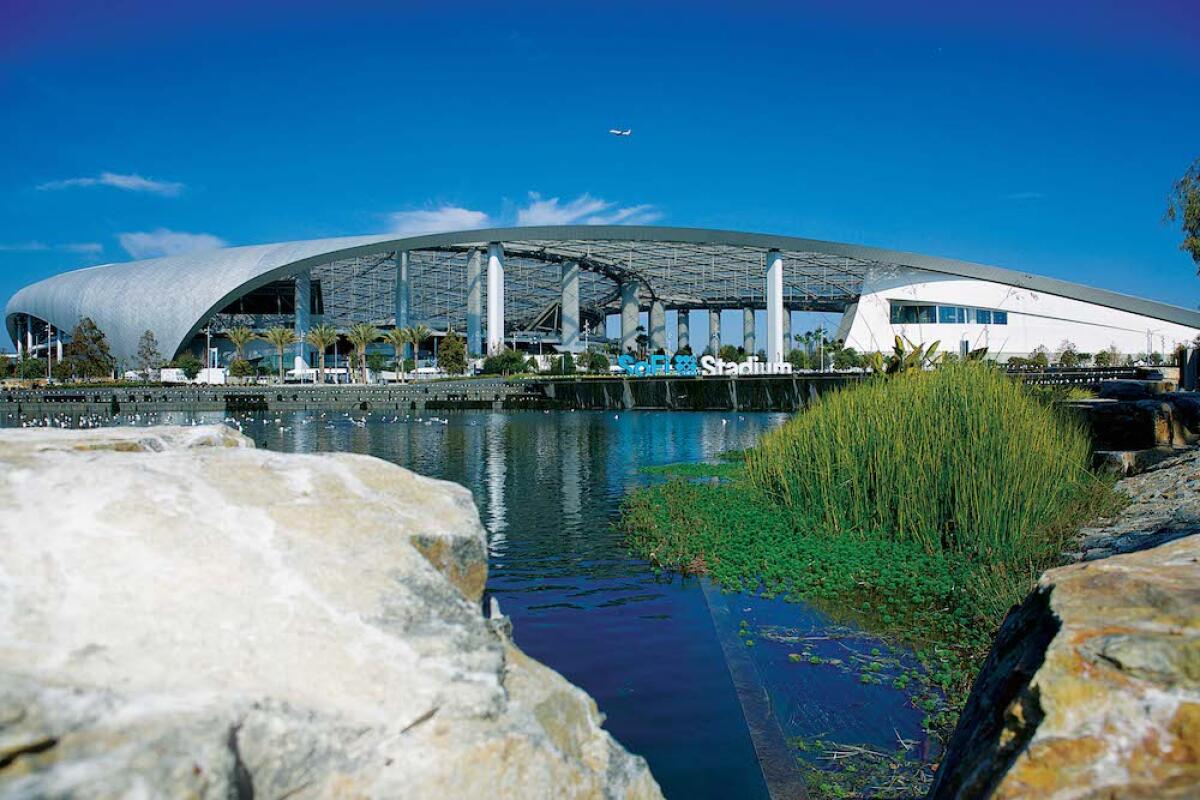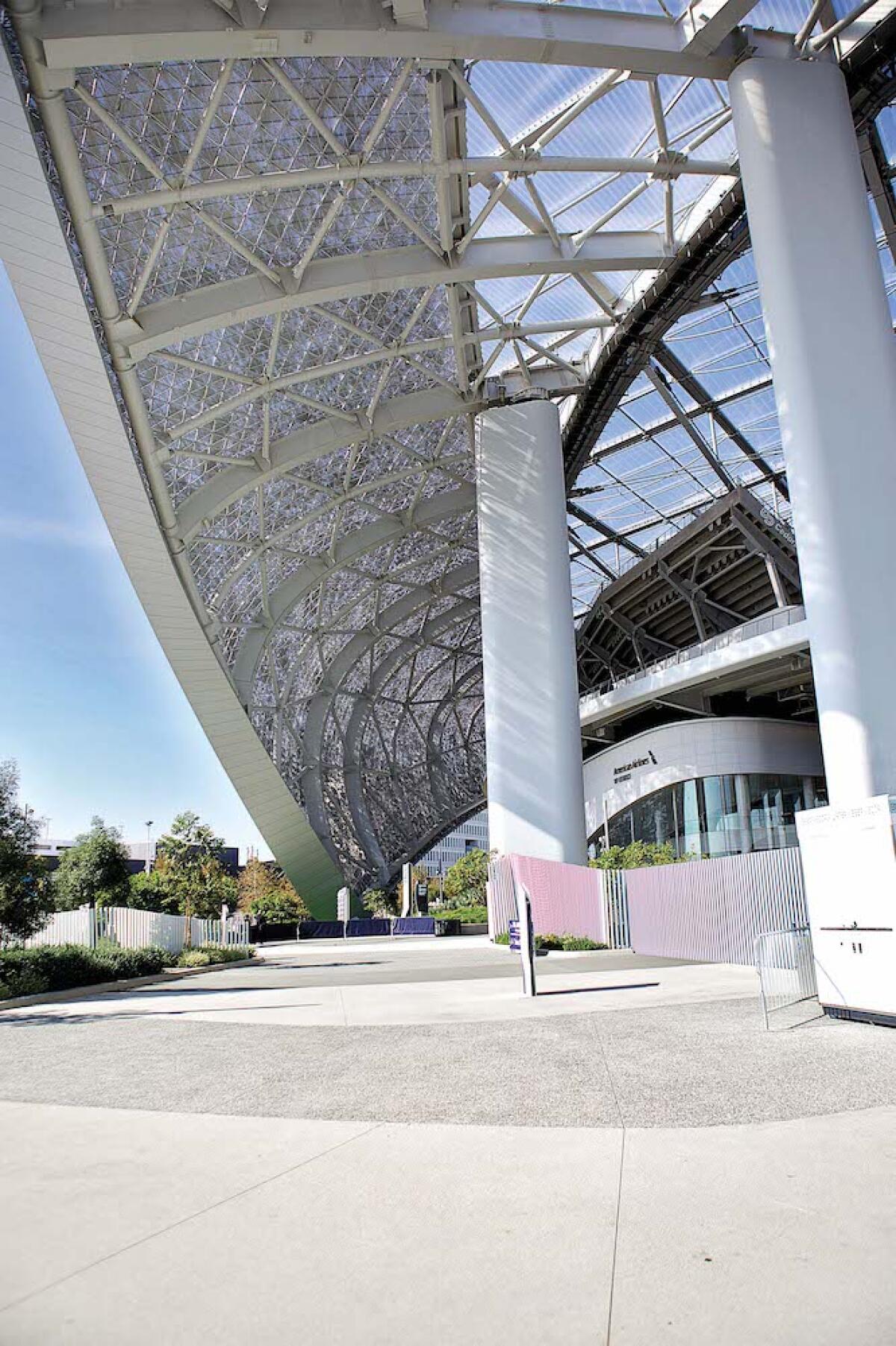SoFi’s Triumph: The Crown Jewel of Inglewood is Steeped in History

- Share via
The soaring SoFi Stadium is the single most significant catalyst of Inglewood’s recent rebirth as the sports and entertainment center of Los Angeles County. Rising from the bygone era of Hollywood Park Racetrack, the state-of-the-art, 70,000-seat arena (room for 100,000 with a standing-room-only crowd) has brought two NFL teams and a Super Bowl to Los Angeles for the first time in a generation, and the Olympic Games opening ceremony to Inglewood for the first time ever. It forms the centerpiece of the Hollywood Park multi-use mega-development that is the heartbeat of the city’s astonishing comeback.
Old Hollywood
Hollywood Park occupies the site of the old Hollywood Park Racetrack, which opened to great fanfare in 1938. Although the brainchild of prominent members of the Hollywood movie community, hence the seemingly incongruous name, Inglewood was chosen because of the ocean breezes that make it palpably cooler than most of inland Los Angeles, and because of its abundant flat ranchland.
Movie moguls from the golden age of film opened what was then called the Hollywood Turf Club. Inspired by the recent openings of thoroughbred racecourses in Santa Anita and Del Mar following a change in California gambling laws, the fellow stakeholders - including top studio executives, movie directors, and some of the most famous actors and entertainers in the world - envisioned a track closer to home.
Celebrities and their attendant glitz were long intrinsic to Hollywood Park Racetrack, where early regulars included a who’s-who of contemporary Hollywood talent. Indeed, the place was so otherworldly, replete with swans gliding atop artificial lakes and a screened “privacy driveway” for chauffeured high rollers, that it drew comparisons to a movie set.
“Success of the Inglewood racetrack passes all financial expectations,” announced a Los Angeles Times article shortly after the track’s 1938 opening. Even during its first year, daily wagering at Hollywood Park could hit $500,000 - the equivalent of around $10 million today.
The track was closed during World War II and, shortly after its 1949 renovation and reopening, was ravaged by fire. Yet it once again bounced back and boomed for decades, with crowds topping 50,000 for major events.
But by the 1980s, horse racing was falling out of fashion. While celebrities still made appearances at the track, its slow demise had begun. Installing the first synthetic track surface in California and opening the $20-million Hollywood Park Casino only delayed the inevitable, and the notion of building an NFL stadium on the site was being floated as early as the mid ‘90s.
“Racetrack to Continue NFL Pursuit,” announced a 1995 L.A. Times headline. “Plans remain to build a stadium and land a pro franchise.”
The track lingered, with dwindling attendance, until 2013. After 75 storied years, the final race at what was then called Betfair Hollywood Park was on December 22 of that year. So vast was the complex that its demolition took two years to complete, with the funereal implosion of its iconic grandstand on May 31 of 2015.
Reimagined Rebirth
The original mixed-use plan for the old racetrack site, dubbed “Hollywood Park Tomorrow,” was derailed by the financial crisis of the late 2000s. But the essence of its concept - extensive residential, retail, and office/commercial development; a substantial hotel; multiple acres of parkland - was revived in 2013 when Mayor of Inglewood James T. Butts Jr. negotiated an even larger vision for the site with billionaire developer Stan Kroenke, owner of the NFL’s Rams franchise, at a meeting that would prove pivotal.
The new plan, presented by the City of Inglewood as the “City of Champions Revitalization Initiative” in 2015, added 60 adjacent acres of former parking spaces to the original 238-acre redevelopment. But, more significantly, it incorporated what Inglewood’s City Attorney described as “plans for an iconic, world-class, energy-efficient multipurpose stadium” into the original multi-use development.
The NFL approved the Rams’ relocation to Inglewood in 2016. The following year, after protracted speculation and negotiations, the Chargers announced that the team would move from San Diego to share the new Hollywood Park stadium. Suddenly, after having no NFL team for more than 20 years, little Inglewood pulled off what no other city had been able to do, and the L.A. region had two pro ball teams. The “City of Champions,” as Inglewood had become known during decades as home to the Los Angeles Lakers and Kings, was back.
Southland football fans were ecstatic, and the celebration continued when it was announced that the new SoFi Stadium would host Super Bowl LVI in February 2022. For while L.A. had hosted the first ever Super Bowl in 1967, the annual championship game had not come to town since 1993. For Inglewood, this high-profile “first” confirmed its rebirth as a regional hub for professional sports, a status surrendered when the Lakers and Kings departed the city’s Forum arena back in 1999.

SoFi Joins In
Online personal finance startup SoFi put its name on the new Inglewood Stadium in 2019. The fact that such a young company, founded only in 2011, scooped naming rights for the most expensive sports stadium ever built seemed appropriate for the sense of fresh, future-facing prosperity for Inglewood that has surrounded the entire Hollywood Park development.
And what a development it is. As well as the 3.1-million- square-foot arena itself, Hollywood Park is a city-within-a-city. It comprises the 6,000-seat YouTube Theater, up to 2,500 brand-new residences, a retail district that will reach up to 890,000 square feet, the aforementioned 300-room hotel, and up to five million square feet of creative office space. A six-acre artificial lake forms the focus of its 25 acres of leafy parkland, for the enjoyment of Inglewood residents and the general public alike.
Alongside the renovation and reopening of the legendary Forum as a world-class venue in 2014 and the announcement of the $1.2-billion Intuit Dome arena, scheduled to debut as the home of the NBA’s Los Angeles Clippers in 2024, SoFi Stadium signaled Inglewood’s renaissance in emphatic fashion. The related turnaround for the city over the past decade has been astonishing, marked by soaring property values, plunging crime, thousands of new jobs, and the city’s bond rating increasing from BBB- to AA- since Mayor Butts took office in 2011.
But it is the architecturally stunning SoFi Stadium that grabbed most of the headlines. Opened in September 2020, it’s an engineering and technological wonder that has raised the bar for stadiums worldwide.
As the NFL’s first indoor-outdoor stadium, SoFi is covered by a swooping translucent canopy embedded with tens of thousands of LED pucks that can project video content visible to planes heading to or from Los Angeles International Airport. The stadium bowl has open sides, and its seating for 70,240 spectators can be expanded to over 100,000.
Inside, the suspended, 360-degree Oculus Infinity Screen by Samsung provides an incredible 80 million pixels of images and information to crowds below. And it is just one of 2,600 large-format LED displays throughout the stadium, comprising more than 131 million pixels in all. SoFi is entirely cashless, meaning fast and reliable transactions, with shorter lines, at all of its hundreds of purchase points.
“A Tipping Point”
SoFi Stadium is the flagship of both Hollywood Park and the new Inglewood, with the taxes and visitor dollars it generates being felt throughout the revitalized city. It shares its canopy with American Airlines Plaza and YouTube Theater and is surrounded by amenities and attractions that encourage big game attendees to make a day of their Inglewood visit, while also enhancing livability for local residents. SoFi is a magnet both to sports fans and other new businesses, with a direct and indirect economic impact that will be felt for decades to come without disrupting Inglewood’s distinct character or culture.
“It’s built sunken 100 feet into the ground ... so it doesn’t overpower the city,” said Butts, who joined Kroenke at the new stadium’s ribbon-cutting ceremony. “It’s a structure that fits in with the topography of the city. And it’s a beautiful thing.”
Butts insisted upon local hiring provisions to ensure that many of Hollywood Park’s jobs went to Inglewood residents. 30% of construction-related SoFi Stadium jobs were targeted for locals, with a 15% Inglewood resident apprenticeship goal established to provide opportunities to inexperienced area workers. The stadium alone created over 3,000 event-day positions, and Super Bowl LVI will provide thousands more temporary jobs. There are also hard-to-hire provisions in place to offer a chance at a productive career to felons in a city that once wrestled with crime.
When the SoFi Stadium hosts the prestigious opening ceremony of the 2028 Summer Olympics, it will both initiate the most spectacular sporting competition on Earth and confirm the venue, and Inglewood, as a global sports and entertainment capital.
“I knew that we were going to be forever changed,” said Butts. “And that was a tipping point.”